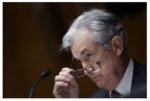High political drama in recent days included the assassination of former Japanese Prime Minister Abe and the resignation of UK Prime Minister Johnson. Yet, the capital markets in general, and the currency market in particular, were not roiled. This is because investors have their sights elsewhere. The dollar surged. It is partly a function of bad news elsewhere. Japan's easy monetary policy stance sticks out like a sore thumb, and the May data showed the economic recovery from the contraction in Q1 is faltering. Industrial output slumped by a stunning 7.2% in the month, and household spending unexpectedly fell. The euro has been driven to new 20-year lows as short-term interest rate differentials move against it. The energy shock is intensifying. Arguably,
Topics:
Marc Chandler considers the following as important: 4.) Marc to Market, 4) FX Trends, Featured, newsletter, USD
This could be interesting, too:
Nachrichten Ticker - www.finanzen.ch writes Die Performance der Kryptowährungen in KW 9: Das hat sich bei Bitcoin, Ether & Co. getan
Nachrichten Ticker - www.finanzen.ch writes Wer verbirgt sich hinter der Ethereum-Technologie?
Martin Hartmann writes Eine Analyse nach den Lehren von Milton Friedman
Marc Chandler writes March 2025 Monthly
High political drama in recent days included the assassination of former Japanese Prime Minister Abe and the resignation of UK Prime Minister Johnson. Yet, the capital markets in general, and the currency market in particular, were not roiled. This is because investors have their sights elsewhere.
The dollar surged. It is partly a function of bad news elsewhere. Japan's easy monetary policy stance sticks out like a sore thumb, and the May data showed the economic recovery from the contraction in Q1 is faltering. Industrial output slumped by a stunning 7.2% in the month, and household spending unexpectedly fell. The euro has been driven to new 20-year lows as short-term interest rate differentials move against it. The energy shock is intensifying. Arguably, unreasonable expectations about a new ECB tool to minimize the divergence of interest rates have been deflated. The US economic news stream was somewhat better, with the flash PMI composite revised higher and the increase of nonfarm payrolls stronger than expected.
Still, economists cut US Q2 GDP forecasts, and the Atlanta Fed GDPNow tracker stands at -1.2%. The market continues to price in not only a 75 bp hike at the FOMC meeting later this month but another 100 bp in the last three meetings of the year. The employment report showed the labor market remains strong, even if not quite as strong as before. The next series of data will also push the pendulum of market sentiment away from recession talk: headline consumer prices are expected to have accelerated, retail sales likely snapped back after falling 0.3% in May, and industrial output is expected to have edged a little higher. The leading hawks at the Fed may have preferred a different path (though there has been only one dissent for a larger hike), but the year-end rate of 3.25%-3.50% in the Fed funds futures is very much in line with what they advocate. The asymmetry of the Fed's path is evident in its unconditional commitment to restore price stability while hoping not too much economic harm is done in the process.
Dollar Index: A new 20-year high (~107.80) was set ahead of the weekend and before the US jobs report. Since the end of the first quarter, the Dollar Index has fallen in only three weeks and only once in the past six weeks. The next important technical area is seen in the 109.25-110.00 range. The MACD and Slow Stochastics are still increasing, but the rapid rise, almost 3% over the past two weeks, lifted DXY above its upper Bollinger Band (~107.15) over the past four sessions, though it finished last week inside it. A pullback into the 105.85-106.20 area may be a better opportunity for bulls.
Euro: The selling has been intense. The immediate pressure subsided after it could not make new lows following the US jobs report. A bout of short-covering lifted it a little more than a cent off its lows. It had slid from the July 4 high near $1.0465 to almost $1.0070 ahead of the weekend. Initial resistance is now seen in the $1.0200-$1.0220 area. The precipitous decline takes more than a small bounce to turn the momentum indicators, which are still headed lower even if stretched. It has spent most of the last three sessions below the lower Bollinger Band, which will begin the new week slightly above $1.0170. Another indication of the near-term over-extended condition is the euro's distance from the downtrend line connecting the February, March, and June highs. It is found slightly below $1.06 at the start of the new week. In this year's downtrend, the euro rarely trades more than five or six cents below the trend.
Japanese Yen: Despite intense volatility in the US bond market, the dollar-yen exchange rate traded relatively narrowly in the past week (~JPY134.80-JPY136.60). In fact, the dollar has settled in between JPY135.85 and JPY136.05 for the past four sessions. The greenback has frayed the 20-day moving average (~JPY135.40) on an intraday basis but has not settled below it since late May. The sideways price action is seeing the momentum indicators gently drift lower. If the US 10-year yield continues to move higher after pulling back around 75 bp from mid-June's FOMC meeting, the dollar could be bid to new highs against the yen.
British Pound: Sterling recorded a new two-year low in the middle of last week, near $1.1875. It recovered to set a three-day high ahead of the weekend by $1.2055. The stalling of its downside momentum is seen in the fact that higher lows and higher highs have been recorded for the past two sessions. The MACD has flatlined, while the decline in the Slow Stochastic has begun leveling off. There may be initial scope toward $1.2100, but it requires a move above the $1.2150-60 area that houses retracement objectives and the 20-day moving average to signal anything of note. Despite the UK political drama, the euro fell to almost GBP0.8440, its lowest level in about five weeks. It frayed the 200-day moving average by a handful of ticks ahead of the weekend. Although the euro bounced a little, it could not re-enter the Bollinger Band (~GBP08480).
Canadian Dollar: As part of the broad US dollar rally, the drop in WTI below $100 a barrel, and softer commodity prices in general, the Canadian dollar made marginal new lows for the year on July 5 (~CAD1.3085) before recovering. The takeaway from the Canadian employment report was that there has been little net new job creation in the past two months, but full-time employment increased (~131k) as much as part-time work fell (~135k). While US average hourly earnings slowed for the third consecutive month, Canada's hourly wage rate for permanent workers continued to accelerate. Investors became more aggressive last week. The swaps shifted from a 60% chance of a 75 bp hike at the July 13 central to entirely discounting it. The US dollar found support ahead of the weekend near CAD1.2935, a (61.8%) retracement of the week's rally and the 20-day moving average. A break of that area could signal a return to the CAD1.2840-60 area.
Australian Dollar: All last week, the Australian dollar traded in the July 1 range (~$0.6765-$0.6905). Still, last week, it was the only major currency to rise against the greenback. The momentum indicators have flatlined in their troughs. The 20-day moving average is near the upper end of the range and has closed above it in a month. A convincing move above this area would lift the technical tone. We have highlighted the technical significance of the lower end of the range: It is the halfway point of the Aussie's rally from the pandemic panic low near $0.5500. The next retracement (61.8%) is around $0.6465. Australia reports June employment data on July 14. Full-time job growth has averaged nearly 61.5k a month this year through May, which is about a third higher than in the same period last year. The unemployment rate is at a record low of 3.9% but may have slipped lower. The market is pricing around a 60% chance of another 50 bp hike when the central bank meets again on August 2.
Mexican Peso: The greenback rose to almost four-month highs in the middle of last week near MXN20.7860. It pulled back in the subsequent two sessions, reaching MXN20.3650 before the weekend. The momentum indicators are giving contradictory signals. The MACD may turn lower from overbought territory, while the Slow Stochastic is headed higher. Provided that the MXN20.19 area holds, the bias may be to a higher dollar. That said, the dollar has not closed above the MXN20.68 area, which is the (61.8%) retracement of the decline from the year's high set in March near MXN21.4675. The JP Morgan Emerging Market Currency Index fell by almost 2.7% last week after a 1.3% decline in the prior week. Over the past two weeks, the peso has fallen by nearly 2.8%. Brazil has performed the best in the region, with BRL gaining about 1%. The Colombian peso has depreciated by 6.4%, the most in the region, and among emerging markets, only the South African rand (-6.5%) and the Russian rouble (-16.1%) have done worse.
Chinese Yuan: Last week, the dollar was little changed against the Chinese yuan, slipping by 0.1%. The week before, it rose slightly more than 0.15%. For the better part of the past two months, the dollar has been forming a large wedge/triangle pattern. However, it is getting too close to the apex to be meaningful technically. Still, the takeaway is that the exchange rate is trending sideways, not up or down. The momentum indicators are not generating strong signals, and continued range trading may be the most likely scenario, perhaps between CNY6.6750 and CNY6.7250. By so tightly shadowing the dollar, Chinese officials are accepting a marked appreciation of the yuan against the euro, yen, and most other currencies.
.
Disclaimer
Tags: #USD,Featured,newsletter








